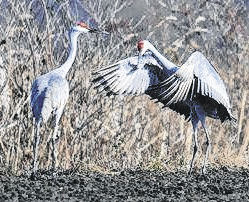You hear the birds long before you see them.
The rattling, clacking, honking call of the sandhill cranes is unmistakable. And at the right time of day and right time of year, the glorious cacophony can be nearly deafening.
Sandhill cranes generally spend the summer in Michigan, Wisconsin, Minnesota and southern Ontario. In the fall, they head south through Indiana. Tens of thousands of the birds congregate at the Jasper-Pulaski Fish and Wildlife Area about an hour north of Lafayette. The wildlife area is 8,142 acres of wetland, upland and woodland game habitat. It is managed by the Indiana Department of Natural Resources to offer feeding, nesting, roosting and cover areas for a wide variety of wild creatures. It’s best known, though, for the cranes.

The best time of year to see the cranes is mid-October through mid-December. A large viewing stand a short walk from the parking area looks out over a large open field where the birds congregate to feed and spend the night. The best times of day to see the most birds is an hour after dawn and an hour before sunset. But many birds spend the entire day in the field, so visitors are nearly guaranteed the chance to see the cranes. In recent years, the peak number of sandhill cranes counted was 26,533 on Dec. 8, 2020.
Several telescopes are permanently mounted on the viewing stand to help visitors see the birds more clearly, but bringing your own binoculars or spotting scope is a better option.
Sandhill cranes are easily identifiable. They stand up to 3½ feet tall, with wingspans up to 7 feet. They have long legs and sharply pointed beaks. Adult plumage is primarily blue-gray with a red, bare skin patch on the forehead. Regardless of age, sex or season, the cranes can be seen bowing to one another and then jumping into the air. They eat a variety of foods, including berries, roots, insects, frogs and grain. They help farmers by eating harmful insect pests and cleaning up waste grain in fields.
If visitors are especially blessed, they might see rare whooping cranes among the sandhills. The birds share a north-south flyway, but whoopers move in much smaller groups and thus are more rarely seen.
Along the short path from the parking lot of the observation stand, visitors will have the chance to quiz themselves about sandhill cranes. Small signs line the paved walkway, with the answers posted at the observation stand. Handicapped parking is available close to the observation stand. Just drive farther along the main road past the regular parking lot.
The fish and wildlife area offers more than birdwatching. There are several fishing sites, where anglers can catch catfish, bluegill and largemouth bass. Some fishing areas are closed during waterfowl seasons. Hunting is allowed in season for both waterfowl and mammals. There also are areas set aside for dog training. Firearm and archery ranges round out the activities. Camping is not allowed. Anyone wishing to go other than to the bird stand needs to obtain a day-use permit.
From Indiana, sandhill cranes generally head south for the winter; although a few actually overwinter at Jasper-Pulaski. Most end up in Alabama and Florida. Johnson County residents generally hear them overhead during both fall and spring migration, with a few spending short periods at the Atterbury Fish and Wildlife Area.
Rich Gotshall is a retired journalist and Franklin resident. Send comments to [email protected].




